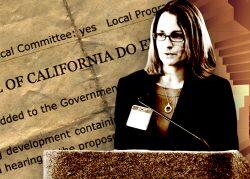A middle-class suburb of Los Angeles has extended a local emergency ordinance that effectively undercuts Senate Bill 9, the sweeping state law that’s billed by supporters as a way to alleviate California’s housing crisis by allowing property owners to split lots and build additional units in residential neighborhoods.
The move comes in Alhambra, a city of roughly 80,000, with more than half of the population Asian-American, about a third Latino, a median household income slightly below the countywide average, and about 40 percent of its housing stock occupied by owners. The Alhambra City Council passed a temporary local ordinance in early January and extended it on February 14. The extension was unanimously approved by the five-member body and continues the ordinance through late December, a time period that snarls any potential local development and raises serious questions about the viability of a signature state housing law.
“The intent here, and the goal here, is just to simply protect our residential neighborhoods,” Councilman Ross Maza said when the ordinance was passed last month, local media reported. “I think most of us have had some type of feedback from our constituents, our residents, with concerns, because we know that many projects that would have been built under SB 9 could permanently damage these residential neighborhoods.”
Other city officials, however, have maintained the local measure – which adds a long list of new requirements for the types of residential development newly legalized under SB 9 – was not intended to contradict Sacramento’s orders.
“Obviously, we weren’t looking to do anything that would be in violation of state law,” Alhambra’s vice mayor, told reporters in January. “As far as I understand it, there were some issues that were built into SB 9 that identified areas that gave cities some flexibility, there were also some other areas that weren’t addressed by SB9. So those are some of the things that we looked at.”
Maza, who is also a real estate agent and owner of a mortgage lending company, did not respond to an interview request from The Real Deal following this week’s extension. The city manager and city attorney also did not respond to interview requests.
Alhambra’s ordinance came as dozens of other California municipalities have passed often creative measures in an attempt to skirt the housing law, which effectively eliminates single family zoning by allowing residential property owners to divide single lots into two parcels and for each of those parcels to have up to two units. (Analysts have predicted the highly controversial law will have a relatively modest impact).
Woodside, a wealthy Bay Area community, gained national notoriety by arguing it should be exempt from the law because adding units on residential properties would disturb its mountain lion population, and other cities have passed laws that attempt to check the law through adding extreme building requirements, such as hedges of evergreen shrubs, fire sprinklers or specific window designs.
“I’m all for mountain lions,” State Sen. Scott Wiener, the author of the law, quipped on Twitter following Woodside’s exemption declaration. “I’m also for people. You know, the ones who need homes.”
Woodside quickly retreated from its argument after a stern letter from the state attorney general’s office. The office did not respond to a query from The Real Deal about Alhambra’s ordinance, but issued a statement that urged city governments to “act in good faith, follow the law, and do your part to increase the housing supply.”
The office also said it was “actively monitoring SB 9 compliance in localities across the state” and was “preparing to take action, where necessary, to enforce the state’s housing laws.”
Alhambra’s ordinance, which was crafted by the city attorney at the direction of council members, stems from a provision allowed under SB 9 that grants cities the option to impose local development standards as long as they are objective and do not prohibit the newly-allowed lot splits and unit development.
Alhambra had plenty of ideas for new standards, amending its municipal code to include stipulations on SB 9-related development that property owners cannot remove any mature trees during construction, that all structures maintain at least 200 square feet of private open space and have setbacks of at least 25 feet, and that any new units have access to an on-site, enclosed garage.
New units also can’t be too big or too small — the sweet spot is between 500 and 800 square feet, and only one story, unless the neighboring property happens to be two stories. The units also must be LEED Platinum certified, and their exterior building lighting must be “shielded and downward facing.” Units that go up on the same parcel as an existing home must be built in the same color and materials.
And, critically, they also must be designated as affordable housing for at least 30 years — meaning that, according to estimated recent figures, a potential tenant household would have to earn less than $39,000, and the property would have to charge less than $975 per month.
In council agendas, the city has argued its rules are a way to bolster environmental protections, maintain certain design standards and add a “superior” supply of affordable housing that’s dispersed throughout the community.
“Obviously, you see some of those things that are important to us, like affordable housing and tree canopy and making sure that we had some consistent design standards,” Maloney, the vice mayor, added in his comments to local media last month. “We would do this for any sort of new development.”
“Some cities just take it too far,” one pro-housing advocate recently told the San Francisco Chronicle. “Putting too many standards in is death by 1,000 cuts.”
Read more

